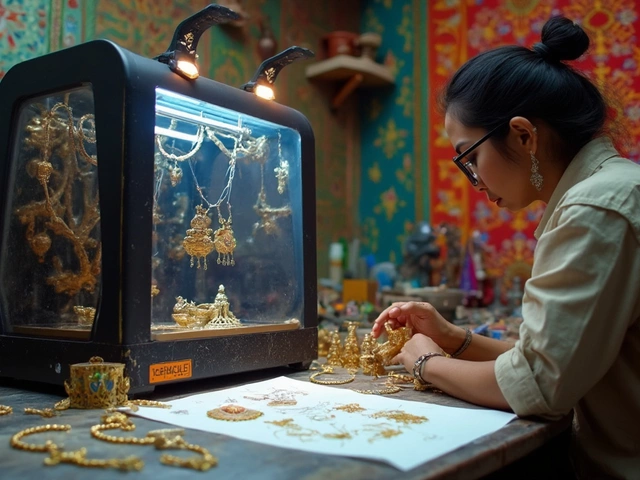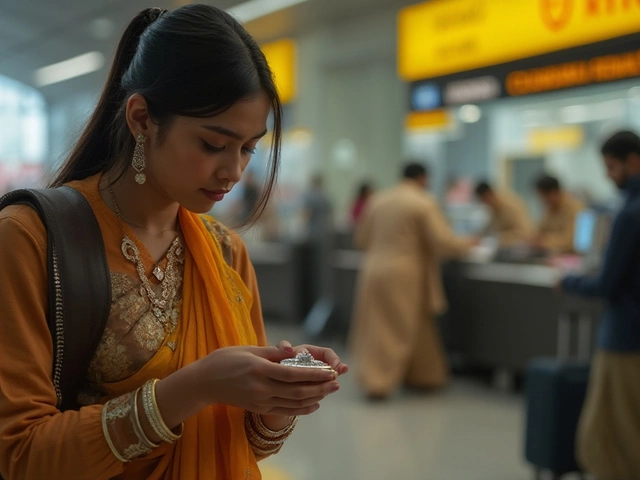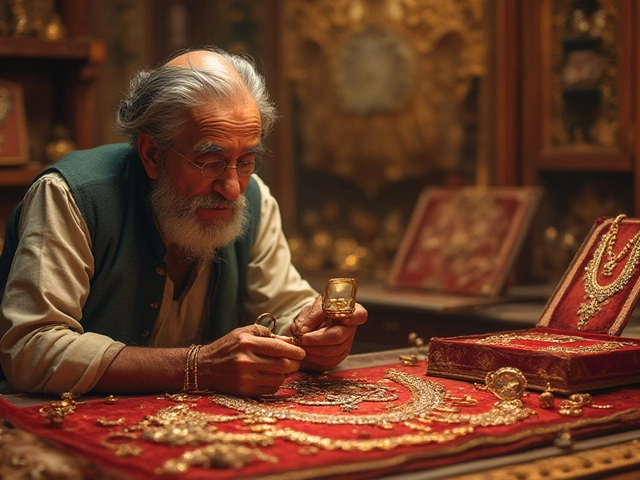The mangalsutra stands as an enduring symbol of marriage, particularly in South Asian communities. It's not merely about adornment; it's rooted in cultural lore, holding an esteemed place in matrimonial customs. But when it comes to sleep, questions often arise—should it be kept on, or is it acceptable to remove it?
This discussion delves into both ends of the spectrum—traditional beliefs and modern-day practicality. As the generations evolve, so do interpretations and practices. Here, we unravel these intricacies, respecting the essence of the mangalsutra while also considering the sway of contemporary lifestyles.
Whether seen as a sacred thread or an elegant part of daily wear, how and when to wear a mangalsutra is often a personal choice influenced by cultural, emotional, or comfort-based reasons. Join us as we explore these facets, offering insights and tips for those who wish to honor tradition without compromising comfort.
- Symbolism of the Mangalsutra
- Cultural Significance in Different Regions
- Day-to-Day Wear: Balancing Tradition and Comfort
- Practical Tips for Wearing Mangalsutra at Night
- Handling and Maintenance of Mangalsutra
- Contemporary Practices and Opinions
Symbolism of the Mangalsutra
The mangalsutra is much more than a piece of jewelry; it carries a profound symbolism that intertwines cultural heritage, spirituality, and personal relationships. Traditionally worn by married Hindu women, the mangalsutra acts as a marker of marital status akin to a wedding ring in the West. Its roots trace back to the ancient Dravidian times, when it was believed to represent a sacred bond between husband and wife. The word 'mangalsutra' itself is derived from ‘mangal’ meaning auspicious, and ‘sutra’ meaning thread, which together signify a 'sacred thread'. This connotation isn’t just semantic—it is deeply rooted in Vedic rituals which regard it as a talisman for the husband's life and prosperity.
Across different regions of South Asia, mangalsutra designs vary, yet the commonality lies in their unifying purpose. In northern India, the mangalsutra generally incorporates black beads and gold, believed to ward off evil and protect the sanctity of marriage. Meanwhile, in the southern states, it's sometimes crafted with intricacies of diamonds and other gemstones, signifying different folklore or community beliefs. Each design choice embeds the intentions of longevity, health, and faithfulness within the marriage.
A popular legend tells of the origin of the mangalsutra involving Lord Shiva and Goddess Parvati. It suggests that when Shiva tied a gold and black beaded mangalsutra around Parvati's neck, it became a divine symbol of their eternal union. This symbolism carries forward to modern times where it still acts as a visual and spiritual reminder of a husband's pledge to take care of his wife. It represents a woman's transformation post-marriage, her transition into a new family, and her commitment therein. Thus, in a way, each mangalsutra acts as a bond, a commitment between two souls, unifying them in a sacred relationship.
In the words of cultural historian Dr. Shastri,
"The mangalsutra stands as an emblem of love, duty, and resilience, encapsulating centuries of faith and social structure."Such views highlight its esteemed status in bridal ceremonies, where receiving the mangalsutra is a moment of joy and sacredness for the bride, often marking the climax of wedding vows. The black beads strung together in many mangalsutras symbolize the unity of two lives, facing life's challenges together, warding off negativity, ensuring that this auspicious bond remains strong throughout life’s adversities.
The mangalsutra also plays a role in societal perceptions and self-identity for many women. Choosing whether to wear it daily is often a blend of personal choice and adherence to tradition. As times evolve, interpretations change, yet the essence remains. Whether viewed through the lens of spirituality or socio-cultural expectations, the mangalsutra is a powerful symbol weaving together personal sentiments with profound communal significance.
Cultural Significance in Different Regions
The mangalsutra holds a revered position in the tapestry of Indian marital customs, but its significance can vary across the diverse regions of India. Each region embodies its traditions which reflect not only in the design but also in the social and spiritual implications attached to this cherished ornament. In North India, it's often woven with black beads and gold, symbolizing the union's strength and resilience. Here, the focus lies on its protective properties, believed to ward off evil and ensure the husband's well-being. Married women find a sense of identity and pride in wearing it as a token of their marital status.
In the southern states, you'll find a distinct variation known as the 'thaali' or 'thirumangalyam.' Its design can vary dramatically from simple to highly ornate, each element carrying unique symbolic weight. The motifs often include symbols like the tulsi plant, representing divine blessings and fertility, highlighting its cultural and religious importance. As a part of the wedding ritual, the mangalsutra becomes a physical symbol of the bond shared between husband and wife, acted upon during sacred ceremonies.
The western states, like Maharashtra, witness the popularity of designs featuring vati pendants, which hold connotations of union and everlasting companionship. These are commonly adorned with pearls or gold embellishments to signify prosperity. The inclusion of intricately designed vatis also marks specific community traditions within the state, each telling its own story passed through generations.
Conversely, in eastern parts of India, though the mangalsutra is worn, it is not as central to wedding customs as in other regions. Here, practices often integrate local cultural elements, like 'Shakha-Pola' bangles among Bengali brides, to denote marital status, while the mangalsutra might serve as an additional symbol rather than a primary one.
The significance of the mangalsutra transcends its role as a jewel into a binding rite, 'It's a marker of being on a perennial journey with their life partner,' as traditionally highlighted by cultural historian Prof. Sita Kamath.
Interestingly, as globalization increases and modern sensibilities evolve, many younger generations are leaning towards new designs that blend tradition with contemporary aesthetics. This includes trends like minimalist designs that can be easily integrated into everyday wardrobes or even be comfortably worn to sleep—allowing women to sustain their cultural heritage while adapting to urban lifestyles. As marriage customs transform, the enduring relevance of the mangalsutra continues to foster a range of influences, making it not just a cultural identifier but also a personal emblem of love and commitment.
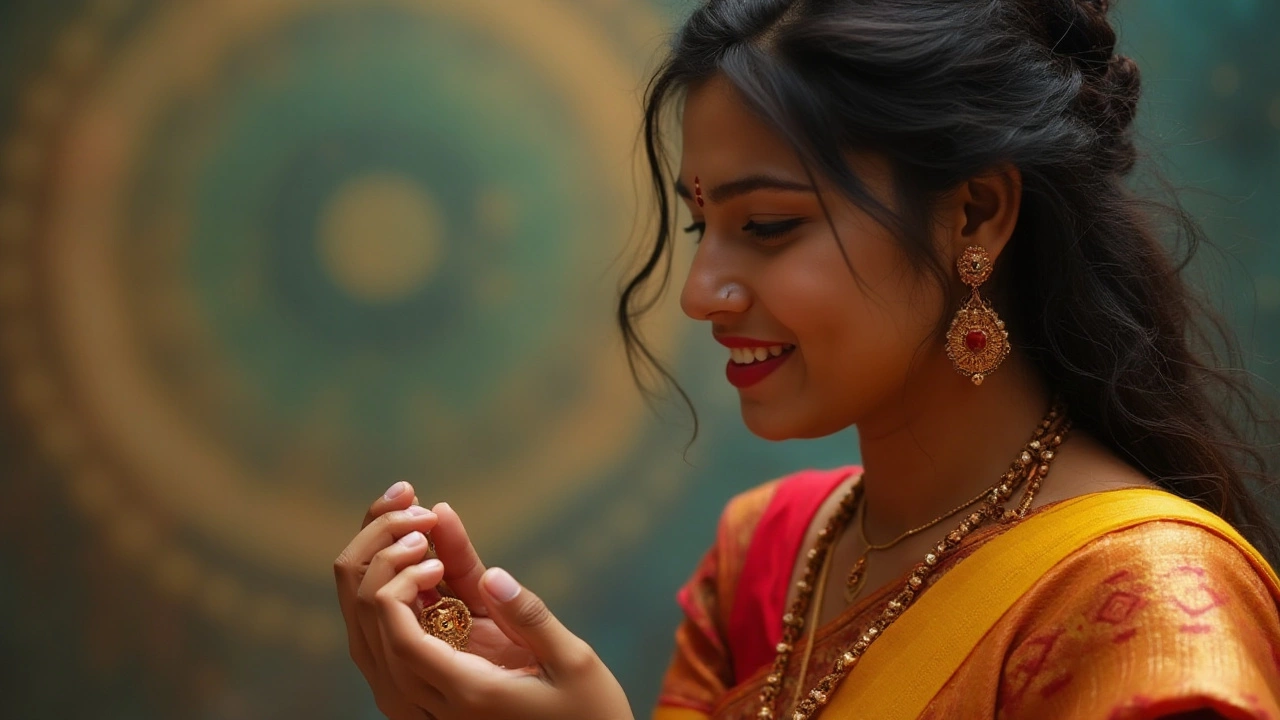
Day-to-Day Wear: Balancing Tradition and Comfort
In the tapestry of marital symbols, the mangalsutra holds an irreplaceable role, woven deeply into the cultural fabric of South Asia. Traditionally, it is emblematic of love, respect, and commitment between a married couple. Wearing it daily is seen by many as not just a ritualistic habit but a deeply affectionate gesture that ties the couple together, irrespective of the day’s events. Yet, in a world that constantly tilts between ancient customs and modern conveniences, many women find themselves asking how best to integrate this traditional adornment into their evolving lifestyles without sacrificing comfort or cultural heritage.
More than just an ornament, the mangalsutra is believed to offer protection. In many households, the thread is said to ward off negative energies and keep the marital bond strong. However, comfort in daily wear, particularly during sleep, raises valid concerns. The delicate chain, often adorned with intricate beads, gemstones, or specific designs, can sometimes feel cumbersome when worn through a restless night. This has led many to adjust their routines, seeking a practical harmony where tradition doesn’t pin them down with discomfort.
Many opt for designs that blend tradition with modern aesthetics, employing lighter materials or flexible chains that allow ease of wear day and night. Some jewelers have innovated designs that respond to a practical need, providing options that do not compromise on the traditional significance yet offer significant comfort. For instance, detachable pendants or lighter options are increasingly popular.
"The evolving styles in mangalsutra designs reflect the changing demands of today's women who embrace their heritage while leading dynamic, modern lives," says renowned jewelry designer Rahul Jain.Embracing changes does not suggest a disregard for the essence of the mangalsutra, but rather an integration of contemporary needs.
Interestingly, there's a growing acceptance of removing the mangalsutra for a sound night's sleep, as long as rituals are performed with respect and love. Elder generations, while holding onto the sanctity of tradition, have shown understanding of this need for convenience, and many young women see this as a balancing act—not as an abandonment of values, but a practical choice in a fast-paced life. To avoid accidental damages or discomfort, some women choose to drape it loosely around their wrist at night or place it securely at their bedside, where they can wear it immediately upon waking.
One might wonder if these modern changes dilute the power and symbolism of the mangalsutra, but it is important to note that its meaning transcends the physical act of wearing it for a lifetime. Its strength lies in the emotional and spiritual commitment it signifies more than its continuous physical wear. As society evolves and family dynamics change, so does the expression of such potent symbols. Through understanding and dialogue, traditions like these find new expressions, keeping them relevant and cherished in diverse lifestyles.
Practical Tips for Wearing Mangalsutra at Night
Wearing a mangalsutra at night can be a delicate balance between adhering to tradition and ensuring comfort. For many women, the sentiment attached to their mangalsutra makes it an inseparable part of their existence. Yet, for practical reasons, some prefer to find ways to either wear it comfortably or opt to remove it without compromising its revered significance. Here are some insightful suggestions to help navigate this decision.
Keeping the mangalsutra on during sleep offers a constant connection to its underlying values while also raising some potential concerns. The chain's material, often gold or a gold alloy, can be delicate, and sleeping with it can sometimes cause tangling, which is more than a minor inconvenience. It's also worth noting that very few compare the night sleep to a time capsule where one’s body isn't conscious to react similarly as during the day. Interestingly, many women prefer shorter chains or lighter versions, which reduce the risk of entanglement without stripping away any authenticity.
Jewelry traditions don't have to be rigid, and a great number of women have found ways around the nuisance often caused by wearing jewelry during sleep. You might consider investing in a mangalsutra with an adjustable clasp, which can slightly adjust the length, offering more flexibility in terms of comfort. Another useful tip is to wrap the chain in a soft cloth before sleep; many have found it not only protects the jewelry from accidental straining but also acts as a gentle reminder of its presence, deterring accidental yank or pull.
Treat the maintenance of your mangalsutra as you would any other valued item. Before entering into a night’s slumber, inspect the clasp to ensure it is secure. It is useful to keep a magnifying glass and a safety pin on your bedside table to double-check any weak links. These small gestures can significantly ease your nights while preserving the jewelry's integrity. As for storing it safely if you choose to remove it, designate a specific place on your nightstand or bathroom sink for the piece, preferably in a small holder designed to keep jewelry from moving about.
A well-known jewelry connoisseur once said, "The way you maintain your ornaments speaks volumes about how you cherish them." Treat your mangalsutra with the care it deserves, and it will continue to remain a proud statement of your marital bond for generations.
Finding the right balance between tradition and comfort often leads enthusiasts to blend practical know-how with cultural awareness. Always tailor these practices based on personal preferences or seek out advice from elders, who might share unique, time-tested methods that have worked for them—providing a bridge between age-old wisdom and present-day ease. When done correctly, wearing a mangalsutra at night can become as seamless as slipping under a warm blanket, offering peace of mind alongside its intrinsic value.
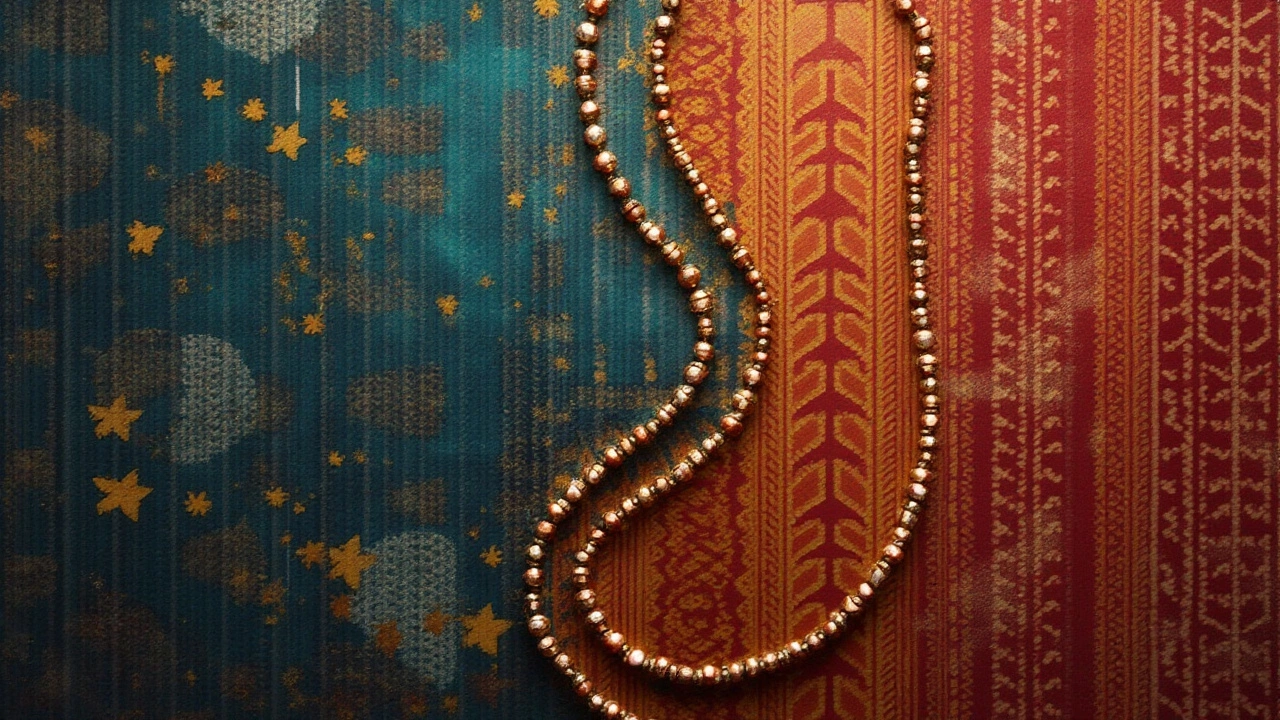
Handling and Maintenance of Mangalsutra
Ensuring the longevity of your mangalsutra involves a blend of care and caution. These significant pieces, often crafted from gold, black beads, or sometimes adorned with diamonds, require thoughtful maintenance to retain their lustrous appeal. Daily exposure to sweat, perfumes, and ordinary dust can tarnish or damage them over time, affecting both their beauty and the sentiment they carry. A common practice to prevent such wear is gently wiping the mangalsutra with a soft cloth, which helps remove daily impurities without scratching the metal or stones.
Most wearers often ask about cleaning solutions. It’s important to note that household chemicals can be too harsh. Instead, lukewarm water mixed with a few drops of mild soap makes a gentle cleansing bath. For more intense cleaning, especially when dirt accumulates in crevices, using a soft-bristled toothbrush can help. However, frequency matters—a once-a-month intense clean is typically sufficient for those who wear their mangalsutra daily. Also, always remember to dry them thoroughly post-cleaning to prevent moisture from causing damage.
Storage of these precious pieces is equally crucial. To avoid tangling with other jewelry, keeping them stored separately in a lined box or pouch is advisable. This practice not only prevents entanglement but also protects the mangalsutra from potential scratches when brushed against other jewelry pieces. Keeping them away from direct sunlight and damp areas prolongs their shine and structural integrity. A wise suggestion is rotating multiple mangalsutras when possible, minimizing wear and allowing pieces to 'rest' between wears.
"Maintaining gold jewelry like the mangalsutra requires attention to detail, ensuring that it is neither over-polished nor neglected," says renowned jeweler Anita Dongre.
The repair of a mangalsutra should not be overlooked. Clasp integrity is particularly important as it secures the piece during wear. If any beads or ornaments come loose, consulting a trusted jeweler for repair is essential. Regular checks can prevent the loss of integral components. Additionally, resizing or restringing might be necessary after years of wear, a meticulous process best managed by professionals.
For those who choose to store their jewelry for longer periods, it is advisable to polish them annually to preserve their polish and shine. Polishing should be handled by skilled jewelers who understand the intricacies of each piece. Using polishing dips or cloths intended for gold and diamond pieces can rejuvenate your mangalsutra, ensuring its brilliance persists through generations. By following these practices, not only do you maintain your mangalsutra's elegance but also uphold its sentimental and cultural significance.
Contemporary Practices and Opinions
In today's world, mangalsutra wearing practices are as diverse as the women who wear them. While traditional beliefs hold firm in certain regions, an increasing number of modern brides view their mangalsutra in a new light. For some, it's a cherished symbol of love and commitment worn proudly at all times. For others, practicality and comfort take precedence as they find themselves balancing traditional values with hectic lifestyles that demand compromise.
The evolution of jewelry traditions like the mangalsutra mirrors broader shifts in societal norms. Today, discussions about gender roles are leading more women to question age-old practices and make choices that align with their personal beliefs. The advent of the cosmic energy of minimalism also means that some choose to wear their mangalsutra only during special occasions, opting instead for simpler, more day-to-day jewelry. Yet, the sentiment around this sacred necklace remains largely positive, with many young women embracing it in creative ways.
"The mangalsutra represents not just marriage, but the bond of love that stands the test of time," says Neha Sharma, a cultural historian.
Among the newer generation, mixed opinions on wearing practices have given rise to a fresh wave of customized mangalsutra designs that cater to personal comfort and style. Designers are responding with versatile options—detachable pendants, adjustable chains, and lightweight materials—that allow women to adapt their traditional mangalsutra to fit their personal comfort levels. Online forums buzz with discussions where people share their thoughts on wearing the mangalsutra to bed, with comfort being the reigning priority in many cases.
Looking at some statistics, a recent survey conducted across urban and rural settings indicates that about 40% of modern brides choose to remove their mangalsutra at bedtime, citing reasons ranging from comfort and skin care to modern fashion preferences. On the flip side, many still choose to keep it on, driven by deep-rooted spiritual convictions and respect for heritage. Whether one views it through a traditional lens or a contemporary one, the mangalsutra remains an enduring symbol that continues to evolve gracefully with time.

